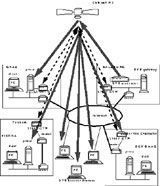-
StatusCompleted
-
Status date2014-12-09
The primary scope of activities to be undertaken within this project is service evaluation of a combined TDMA/DVB satellite network for Internet/Intranet services. The DVB network consists of an application-orientated software platform which supports various interactive data services via communications satellites and networks. The TDMA-VSAT system (in the following named 'LISSY') is used for interactive services like local network interconnection in a traditional, symmetric configuration i.e. forward and return link utilize the same channel. The goal of the project is the set-up, configuration, service evaluation, and accompanying measurements and analysis of a prototype system suitable for pre-commercial demonstrations of :
- High-quality voice/video services
- Asymmetric high-speed interactive
- Internet services Fully-reliable high-speed multimedia multicast push services
- High-speed LAN interconnection via satellite
Today, video, voice and data applications are widely supported via networks using the IP protocol. Particularly multimedia applications such as tele-instruction, tele-medicine, tele-science, access to multimedia data bases and information services require high bandwidth which is not available in many areas. Novel satellite communications systems can provide efficient solutions. Compared to terrestrial networks, even high-capacity fiber optics systems, the satellite has an important advantage, namely its inherent broadcast capability and offering access directly to the customer's site without the necessity of using an additional access network. When making proper use of this broadcast feature, the performance of the satellite-based system can compare favorably to terrestrial solutions. Internet applications are highly asymmetric making them very well suited to VSAT applications. The data from one source may be used simultaneously by a large number of users.
The present situation is characterized by several problems which are serious drawbacks to a rapid growth of a new industry and widespread availability of its products, in particular:
- Overload of communications links and congestion in routers and switches
- Operation at full capacity with the consequence of severe queueing effects and high delays and packet losses
- New types of applications, in particular multimedia information services and multicast applications (slow scan video and audio) require additional capacities
- A lack of high speed (256 Kbits/sec to 2 Mbits/sec) "delivery networks", particularly for the "last mile" and in rural and less developed areas
- A lack of broadband capacity (100 Mbits/sec to several Gbits/sec) for delivery of multimedia services directly to large groups of end users.
- The proposed network configuration can overcome those drawbacks, the pilot trial shall prove the concept.
Typical challenges for an international organisation spread over several European countries stem from a combination of content distribution and interactive database access, combined with some limited amount of non interactive tele-training and interactive video-conferencing. For the purpose of uni-directional content distribution and tele-training DVB/MPEG-2 provides very reasonable solutions, whereas for highly bi-directional services such as video-conferencing TDMA systems are better suited. Combining these two transmission systems (DVB and TDMA) open novel opportunities for interconnection strategies, exploiting the advantages of these technologies in an effective and economic combination.
The system is fully Internet/Intranet compatible, offering the end user the common browser interface for World-Wide-Web (www) services. It uses standard PC and commercially available interface equipment and, hence, offers a high-speed service at very low cost. For the interconnection of a company4s main sites the TDMA system offers ISDN telephony, video-conferencing and transparent local area network access. Furthermore, any TDMA station acts as feeder station to the DVB uplink station. In the following we will refer to this as "Integrated LISSY/DVB Service Evaluation" (ILSE) system. The applications and services for the evaluation are predominantly targeted at a typical European company having various needs for Internet/Intranet services. This could well serve as a demonstrator of the capabilities of such a system and outline ways in which the system could be used for commercial purposes, in the areas of tele-education and tele-training etc. Two types of architectures can be distinguished which are combined in the overall system architecture:
- Architecture 1: the "main site" scenario where a TDMA Station acts as a central receive/transmit station and provides bi-directional voice/video/data services to the user community. For this project 3 main sites have been interconnected in a full mesh configuration.
- Architecture 2: the "small remote office" scenario with a DVB Receiver Station (DRS) acting as a receive-only terminal for the "forward" link and having transmit capability on a different "return" link back to the server; the return link will be a telephone/modem connection or a connection provided by the TDMA system. Three sites acting as remote offices have been equipped with DVB stations.
|
ILSE network configuration |
The proposed duration of the project is 7 months from kick-off. Kick-off was on 1 April 2000. No hardware and software developments are envisaged. For the purpose of the service evaluation existing LISSY stations in Graz, Salzburg and Vienna (Austrian Telekom) are used and the existing DVB uplink station in Salzburg. The tasks of the activity are as follows:
- definition of a set of services suitable for the user
- network and application configuration for LISSY and DVB/MPEG-2
- installation and testing at user premises
- service trials and evaluation by the user
- accompanying measurements and analyses
- analysis of the market potential and development of a business plan by the user.
The ILSE Project was completed with a final presentation to the senior management of the project participants in September 2000.



